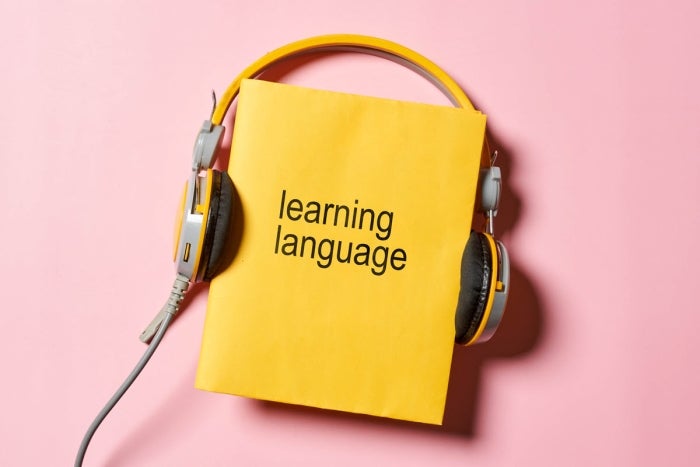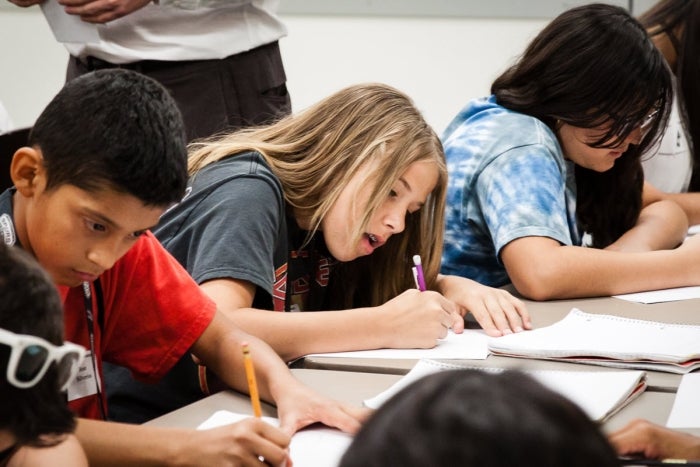Fall 2022 ASU English courses offer reflection, perspective

A jewel-toned lake in the Carpathian Mountains of Ukraine. Photo courtesy Irene Mei/Flickr (used under CC 2.0)
If you’re feeling like recent geopolitical events have that grim, here-we-go-again vibe, you’re not alone. Pundits, politicians and historians have made comparisons to the Cold War, to World War II, even to medieval conflicts.
What to do? Nelson Mandela called education “the most powerful weapon.” In the absence of other kinds of concrete action, perhaps the best strategy for peace — and peace of mind — is to keep learning and growing. (Also, we suggest viewing this heart-warming film about an octopus.)
The Department of English at ASU recommends these fall 2022 courses that offer opportunities for deep reflection. Topics include literature of the Cold War, podcast writing, explorations of ecomedia, craft tips from a Pulitzer Prize-winner and more.
Registration information for a sampling of fall semester classes is provided below. Find more in the ASU class schedule (look for “ENG,” “FMS,” “LIN” or “APL” prefixes), searchable by both online and in-person options.
1. ENG 332 Studies in Race and Ethnicity: Jewish Writers and the Cold War
What it is: How did Jewish writers navigate the political, social and cultural upheavals of the Cold War era? Students in ENG 332 Jewish Writers and the Cold War read the work of major authors such as Franz Kafka, Allen Ginsberg, Philip Roth, Cynthia Ozick and Nicole Krauss, exploring a wide range of topics at the heart of America’s multiethnic literary tradition. Themes include immigration and assimilation; the attraction of radical politics and dissent; sexuality, obscenity and censorship; Holocaust memory; and ethnic and racial passing.
Why it matters: The recent Russian bombing of the Babi Yar Holocaust Memorial outside Kyiv, Ukraine, is a reminder against forgetting. Have we been here before?
Who’s in charge: ASU Assistant Professor Brian Goodman, an affiliate of ASU Jewish Studies and the Melikian Center for Russian, Eurasian & East European Studies, teaches this course. Goodman is the author of “Philip Roth's Other Europe: Counter-Realism and the Late Cold War," published in the journal American Literary History, and a book forthcoming from Harvard University Press on literary dissent between the U.S. and Czechoslovakia during the Cold War.
Who should take it: ENG 332 is open to undergraduates of any major who have an interest in literature, fiction, history, poetry, language, writers and writing, activism, race and ethnicity, ethics or politics who have met basic first-year composition requirements.
If you register: ENG 332 Studies in Race and Ethnicity: Jewish Writers and the Cold War (class # 87320) meets Mondays and Wednesdays from 3 to 4:15 p.m. on ASU’s Tempe campus.
2. ENG 419 Writing for Podcasts
What it is: In ENG 419 Writing for Podcasts, a writing course with practical applications, students learn about effective podcast writing practices and how to put these techniques to work in their own audio productions. The course examines how the emergence of podcasting is transforming how writers explain, define, summarize, compare and contrast different types of information through audio media.
Why it matters: Digital communication skills are highly valued by companies and nonprofits. A successful, well-rounded, 21st-century communicator must pay specific attention to context, audience and meaning-making.
Who’s in charge: ASU Assistant Professor Jacob Greene, a specialist in digital media and rhetoric, teaches the course. Greene is the author of “Advanced Exposition: Writing through Podcasts” for the journal Composition Studies (2018).
Who should take it: ENG 419 is open to advanced undergraduates of any major who have an interest in writing, digital tools, podcasting, communication, rhetoric, argument, narration, social media or journalism, who have met basic first-year composition requirements.
If you register: ENG 419 Writing for Podcasts (class # 93049) meets Tuesdays and Thursdays from 12 to 1:15 p.m. on ASU’s Tempe campus.
3. ENG 394 Voices from the Margins
What it is: Students in ENG 394 Voices from the Margins investigate marginalized voices in literature, the cultural and political forces that push their work to the margins, and the ways writers challenge that oppression. With a reading list that includes heavy-hitters like Toni Morrison, Tommy Orange, Nana Kwame Adjei-Brenyah, Ocean Vuong, Audre Lorde, Vievee Francis and John Murillo, the class will consider both the content and the craft of each work.
Why it matters: Who decides who belongs?
Who’s in charge: Mitchell Jackson, the John O. Whiteman Dean’s Distinguished Professor at ASU, teaches this course. Winner of a 2021 Pulitzer Prize for his article in Runner’s World magazine about Ahmaud Arbery, Jackson is also a columnist for Esquire, where he regularly writes about issues of racial justice and equality.
Who should take it: ENG 394 is open to undergraduates of any major, who have an interest in literature, fiction, nonfiction, poetry, writing, multiethnic literatures, cultural studies or marginalized voices, who have met basic first-year composition requirements.
If you register: ENG 394 Voices from the Margins (class # 90489) meets Mondays from 4:30 to 7:15 p.m. on ASU’s Tempe campus.
4. FMS 394 Media and the Environment / FMS 385 Ecomedia
What it is: Countering the perspective that what happens on our screens is disconnected from “real life,” FMS 394 Media and the Environment / FMS 385 Ecomedia teaches students about the embedding of environmental ideologies and imaginaries within film and media production, design and representation. Participants learn how specific media forms — such as satellite imaging, video games, animation and documentary film — can uniquely enable ecological messaging. The course, which is in the process of being renamed to more accurately reflect its focus, has students engage creatively with class material by telling their own eco-stories on a digital platform.
Why it matters: In this case, media are not just the “messengers,” but also actors upon the environment. It is important that these powerful technologies help mitigate — rather than add to — the deepening climate crisis.
Who’s in charge: ASU Assistant Professor Lisa Han, who focuses on environmental media, ocean studies and the energy humanities, teaches this course. Han is co-organizing an upcoming Earth Day symposium, "Ecologies and Infrastructures: Cultural Techniques of Environmental Management,” for April 22.
Who should take it: FMS 394 / FMS 385 is open to undergraduates of any major who have an interest in film, documentaries, digital technology, sustainability, environmental activism, ecomedia, satellite imaging, video games, animation, social media, ecology, social justice or media production.
If you register: FMS 394 Media and the Environment / FMS 385 Ecomedia (class #97190) meets Mondays and Wednesdays from 4:30 to 5:45 p.m. on ASU’s Tempe campus.
5. APL/ ENG 557 Computer-Assisted Language Learning (CALL)
What it is: Offered with both applied linguistics and English prefixes, APL 557 / ENG 557 Computer-Assisted Language Learning (CALL) traces the development of technology-enabled language teaching and learning over the last three decades, relying on a data-centered approach. Students participate in a research study as part of their coursework.
Why it matters: Current and future educators must stay up-to-date on the latest pedagogy and research methodology in language learning and technology in order to compete in an increasingly complex and connected world.
Who’s in charge: Professor Bryan Smith, director of the graduate certificate in computer-assisted language learning (CALL) at ASU, teaches this course. An English Language Specialist with the U.S. Department of State, Smith is editor (along with Ana Oskoz) of the international CALICO Journal, which is devoted to research and discussion on technology and language learning.
Who should take it: APL 557 / ENG 557 is open to graduate students in any field who have an interest in language, technology, linguistics, teaching, virtual learning, human-computer interaction or research methodologies.
If you register: APL 557 (class # 95276) / ENG 557 (class # 95830) Computer-Assisted Language Learning is offered in a hybrid format, meeting virtually, asynchronously and on Fridays from 10:30 to 11:45 a.m. on ASU’s Tempe campus.
6. ENG 501 Approaches to Research: English Education
What it is: ENG 501 Approaches to Research: English Education introduces students to multiple methods for conducting research within the English language arts setting. Not only do course participants read and critique others’ work, they also bring in a bit of the personal by identifying and defining their own research positionality.
Why it matters: Today’s language arts professionals, whether teachers themselves or teacher-trainers, rely on qualitative and quantitative research to guide them in their classrooms.
Who’s in charge: ASU Assistant Professor Gabriel Acevedo Velázquez, an English education specialist who uses identity as a framework for research and inquiry, teaches this course. Acevedo Velázquez is the author of “Gringo or Rican or Just Me” in the edited collection “Critical Storytelling: Multilingual Immigrants in the United States” (2020).
Who should take it: ENG 501 is ideal for in-service language arts teachers and any graduate student with an interest in education research, language arts, writing pedagogy, teaching, educational theory or research methodologies.
If you register: ENG 501 Approaches to Research: English Education (class # 82160) is offered on Mondays from 4:30 to 7:15 p.m. on ASU’s Tempe campus.
More Environment and sustainability

Homes for songbirds: Protecting Lucy’s warblers in the urban desert
Each spring, tiny Lucy’s warblers, with their soft gray plumage and rusty crown, return to the Arizona desert, flitting through the mesquite branches in search of safe places to nest.But as urban…

Public education project brings new water recycling process to life
A new virtual reality project developed by an interdisciplinary team at Arizona State University has earned the 2025 WateReuse Award for Excellence in Outreach and Education. The national …

ASU team creates decision-making framework to improve conservation efficiency
Conserving the world’s ecosystems is a hard job — especially in times of climate change, large-scale landscape destruction and the sixth mass extinction. The job’s not made any easier by the fact…







